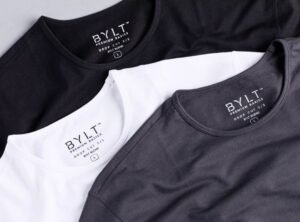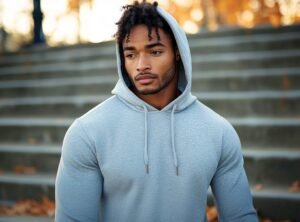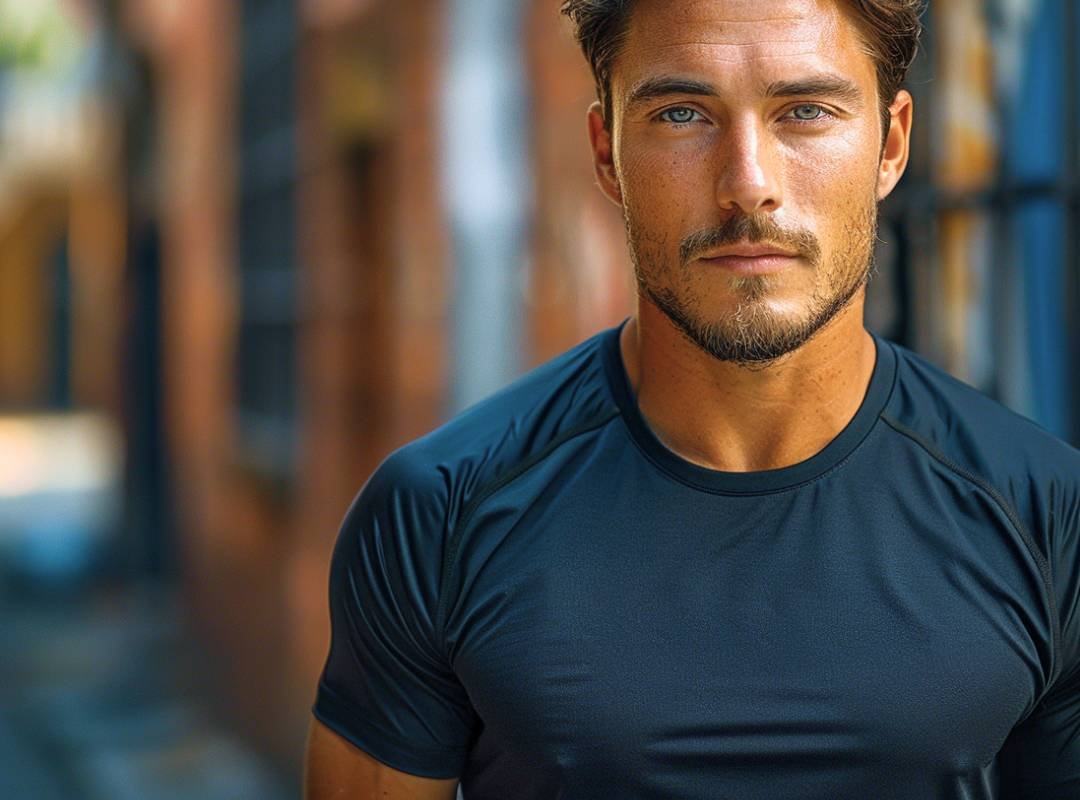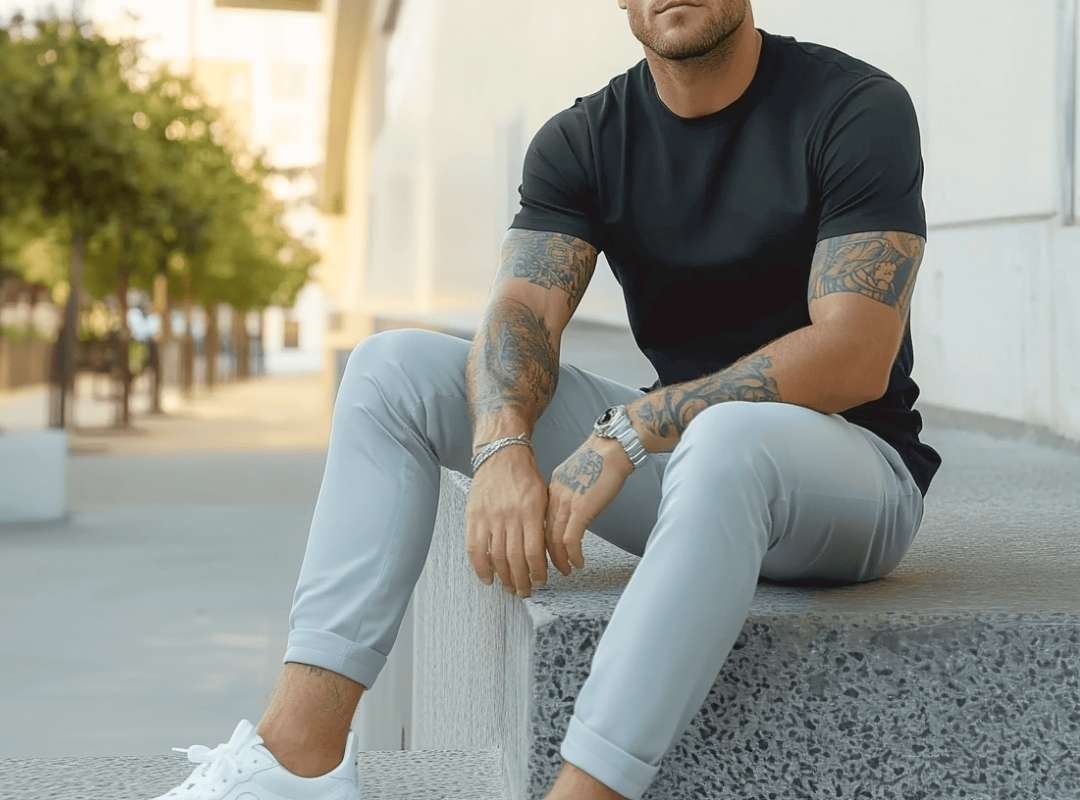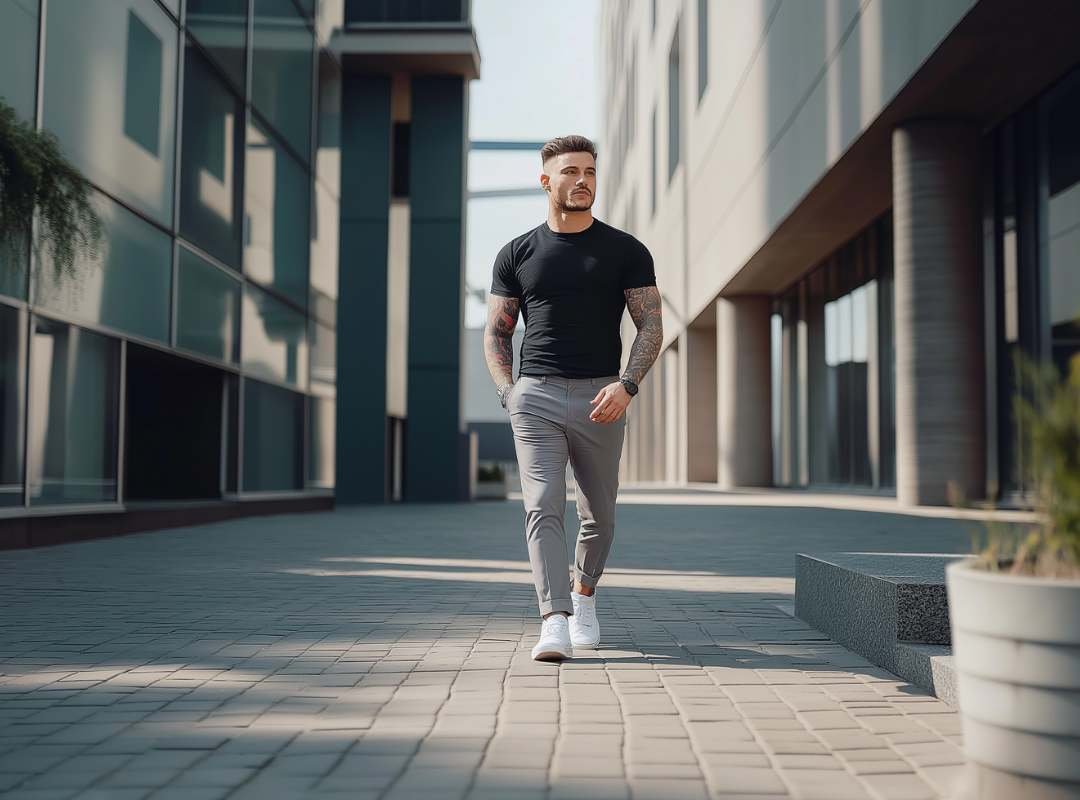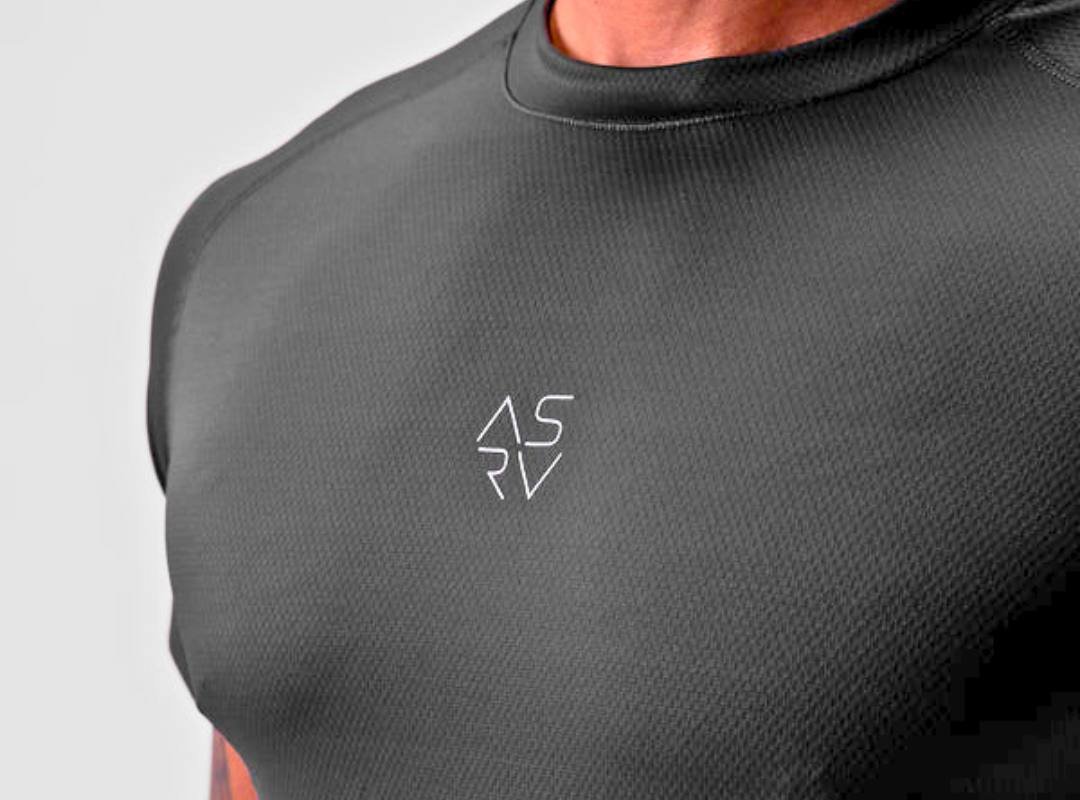As we push our bodies during workouts or outdoor adventures, keeping cool and dry is key to powering through without distraction. Thankfully, advancements in athletic apparel have led to moisture-wicking fabrics that do just that.
These technical fabrics have a unique knit structure and fiber blend designed to pull sweat off your skin and disperse it across the surface, allowing rapid evaporation so you stay drier.
Beyond the gym, moisture-wicking properties also appear in casual and business attire. The benefits translate to the boardroom or a night out when you want to look sharp without sweating through your shirt.
What Does Moisture Wicking Mean?
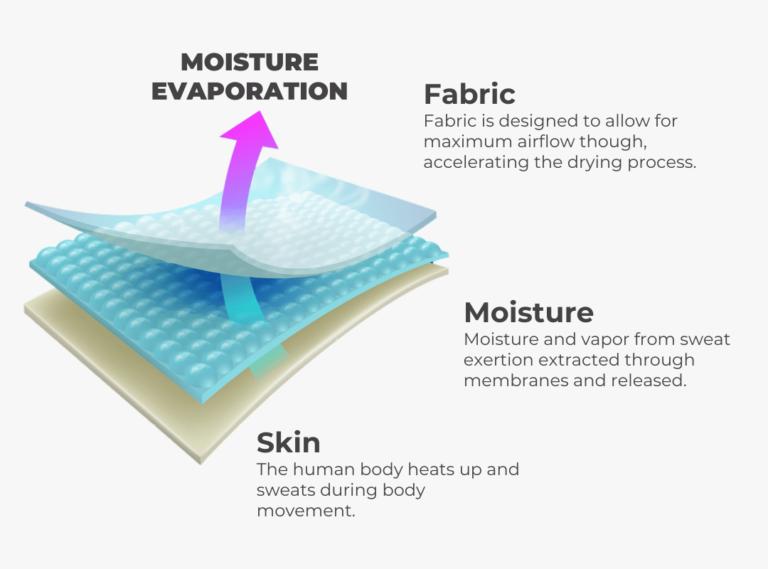
Before diving into the science, let’s clarify what moisture-wicking means and why it matters daily. These fabrics have a structure that lifts moisture from your skin to the outer surface rather than absorbing it. This allows sweat to evaporate rapidly, keeping you more relaxed and regulating your body temperature more effectively.
Moisture-wicking properties target perspiration during physical activity but apply to humid outdoor conditions or simply high heat. Instead of wearing a sweat-drenched cotton tee that gets heavier as you sweat, wicking performance fabrics stay light and dry regardless of exertion level or environmental factors.
The result is superior comfort that eliminates wet clinginess and helps reduce chafing or irritation. For athletes, staying dry also helps maintain body temperature so you can power through high-intensity training without overheating.
Beyond the functional benefits, wicking fabrics also resist odor longer since less moisture is absorbed for bacteria to feed on.
Science Behind Moisture-Wicking
So, how do these fabrics move moisture? It comes down to capillary action and how the knit structure influences movement. Capillary action describes how liquids flow through narrow spaces due to adhesive forces between the liquid and the touching surface.
To create effective moisture wicking, fabrics have a woven or knitted structure with micropores wide enough to allow sweat to adhere and travel. Instead of beading on the hydrophobic fibers, the sweat spreads and moves to the surface for rapid evaporation.
The material makeup is also vital. High-tech athleticwear blends include synthetic fibers like polyester or nylon that water latches onto and moves through quickly. For casual, versatile pieces, moisture-wicking shirts and pants may blend cotton with 5-15% spandex to retain the natural feel of cotton while still offering enhanced drying performance.
Understanding the science behind wicking technology allows you to seek it out in gym clothes and casual or business attire. Performance benefits aside, no one enjoys feeling sweaty or changing mid-day, so consider pieces with moisture management if you run warm.
The next time heat or humidity threatens to dampen your day, reach for fabrics engineered to keep you cool, dry, and comfortable.
Watch this video from Hip Science. It’s almost ten years old, but it’s the best explanation I found in my research.
Types of Moisture-Wicking Material
Several fabric options, both synthetic and natural, provide effective moisture wicking. Standard options include polyester, nylon, rayon, wool, cotton blends, and, more recently, plant-based fibers like bamboo. The type of activities or climate you’ll wear them in determines the ideal textile.
Table: Types of Moisture-Wicking Materials
| Material | Type | Best Uses | Key Benefits |
|---|---|---|---|
| Polyester | Synthetic | Athletic clothing, everyday wear | High sweat-wicking capability, quick-drying, does not absorb moisture |
| Nylon | Synthetic | Hiking, climbing, sports gear | Lightweight, durable, low moisture absorption, effective moisture-wicking |
| Rayon | Semi-synthetic | Casual wear, mixed fabric garments | Soft, silky feel, decent sweat-wicking with blends like modal enhancing performance |
| Wool (Merino) | Natural | Outdoor apparel, performance wear | Natural moisture management, temperature regulation, prevents odor |
| Cotton Blends (with spandex or polyester) | Natural/Synthetic Blend | Everyday casual and office wear | Improved moisture control and shape retention when blended |
Polyester remains the most ubiquitous moisture-wicking fabric. As a synthetic polymer fiber, it’s specially engineered to wick moisture from the skin and disperse it rapidly across the fabric surface for quick evaporation.
Polyester offers the highest sweat-wicking capabilities of all performance fabrics and dries much faster than cotton. The hydrophobic fibers do not absorb moisture.
Is Polyester moisture wicking?
Yes, polyester is explicitly engineered for moisture-wicking and evaporative cooling. It reigns supreme for athletic clothing but blends well with cotton or other fabrics.
Nylon is a synthetic fiber that shares many performance attributes with polyester. With a high strength-to-weight ratio, nylon fabrics are lightweight and durable—ideal for hiking or climbing gear. The hydrophobic material also proves moisture-wicking by spreading sweat over a large surface area and preventing absorption.
Is Nylon moisture-wicking?
Like polyester, nylon is a synthetic fiber tailored for effective moisture-wicking to keep athletes cooler and drier. It shares durability and a low moisture absorption rate.
Rayon is an interesting middle ground between synthetic and natural fabrics. Made of wood pulp, it requires extensive processing with chemicals to produce fibers. Rayon feels similar to natural fabrics like cotton but with a soft, silky feel.
Most rayon has decent sweat-wicking capabilities, though blended types like modal excel in moisture control.
Is Rayon moisture-wicking?
On its own, rayon is moderately effective at wicking moisture. However, variants like modal and lyocell blend rayon with other fibers using advanced spinning methods, significantly enhancing breathability and moisture control.
Wool is unusual as a natural fiber that still provides moisture management. The fibers naturally wick moisture from the inner layers near the skin outward. Merino wool specifically excels here – the ultra-fine fibers don’t absorb liquid but instead allow vapor and sweat to pass through while preventing odor.
The result is natural temperature regulation, which is ideal for outdoor apparel.
Is Wool moisture-wicking?
Despite being an animal fiber product, wool has an unusual natural moisture-wicking capability. Merino wool, in particular, balances sweat control with softness for excellent performance apparel.
Cotton is perhaps the most comfortable and casual fiber but has limited inherent moisture-wicking ability. The hydrophilic structure absorbs moisture rather than wicking it. However, cotton can be blended with synthetic performance fabrics to retain comfort while gaining sweat-wicking power. A 5-15% spandex or polyester blend substantially improves shape retention and moisture control.
Is Cotton moisture-wicking?
On its own, no-cotton absorbs moisture rather than wicking it away from the skin. However, blending with performance fabrics introduces moisture-wicking to versatile dailywear pieces.
Synthetic vs Natural Moisture-Wicking Fabrics
Modern sweat-wicking apparel contains a range of natural and synthetic technical fabrics. Each has comparative advantages and disadvantages regarding performance, comfort, and environmental impact.
Synthetic fibers like polyester and nylon lead the pack regarding true performance capability. The polymer materials are specially engineered to lock moisture in quickly and lift it to the surface. Pieces made purely of polyester or nylon will dry the fastest and feel the lightest during intense training.
However, many athletes and outdoor enthusiasts find pure synthetics unpleasant, slick, and plastic-like against the skin. Here’s where trusted natural fibers like Merino wool bridge the gap—providing temperature regulation and moisture control on par with synthetics while feeling softer.
The environmental impact also favors responsibly sourced wool or plant-based fibers. Synthetics like polyester shed microplastics into waterways during washing. Brands now recycle plastic bottles into polyester, but biodegrading fibers like wool or cotton have a clear upside.
As moisture-wicking technology advances, we’ll see the best of both worlds blended into fabrics. This means breathable cotton-poly blends for casual shirts or wool-nylon blends for socks and base layers. Enhanced finishing processes like nano spinning will also let more natural fabrics compete on performance.
Ultimately, the ideal moisture-wicking fabric blend balances activity needs, comfort, and eco-impact. The good news is that quality options exist on all fronts—whether sweating it out on a trail run or just looking sharp at the office.
How Moisture-Wicking Fabrics Work
To understand moisture-wicking apparel, we must explore the structural design and fabric technologies that drive sweat control. These fabrics excel at moving moisture thanks to specialized knits, weaves, fiber blends, and mechanical or chemical finishes.
On a microscopic level, sweat-wicking fabric fibers have unique shapes and surfaces that prevent moisture from fully absorbing. The textures then encourage liquid sweat to adhere and spread out rapidly. This moisture can quickly reach the outer surface for evaporation instead of accumulating next to the skin.
Besides the fiber shapes and blend ratios, fabric construction plays a key role, too. Moisture-wicking pieces use knitted structures with slightly raised loops of woven fibers. The micro-spaces created provide enough room for moisture to pass through without being fully absorbed.
Moisture-wicking technical fabric pieces also increasingly use advanced knit technologies like nanopore mesh stitching. This high-tech method creates fine nanopore openings, allowing maximum airflow and moisture control. The result is almost like a moisture tunnel system pulling sweat outward.
Performance finishes like durable water repellency (DWR) treatment further discourage absorption by making fabric surfaces water-resistant. This causes moisture to bead up and move across the top rather than sinking in. Pieces like workout shirts or hiking pants rely on DWR to keep heavy rainfall out while breathing.
Advantages and Limitations of Moisture-Wicking Materials
When shopping for moisture-wicking men’s activewear or casual pieces, consider the advantages and limitations common to these technical fabrics.
| Advantages | Limitations |
|---|---|
| Rapid drying performance prevents wet clinginess during workouts or in humid climates | Visible sweat stains on darker synthetic blends even as moisture itself vanishes |
| Cooling effect and sweat dispersion regulate body temperature better for outdoor activities or hot offices | Rubbing from seams or packs can compromise specialty textile finishes over time |
| Odor prevention since less absorbed moisture means fewer food sources for bacteria | Lingering bacteria or body oils may still cause eventual odors without washing |
| Lightweight feel and improved range of motion from moisture-wicking knit structures | Delicate construction means a shorter lifespan for some ultra-high-tech, moisture-wicking pieces |
| Keeps you drier compared to cotton | May feel slick or clingy when completely soaked through |
| Allows evaporation of sweat instead of absorption | Some limit stretch over time with abrasion |
| Stays lighter as you sweat since moisture sits on the surface | Visible sweat stains depend on the color shade |
With the above benefits and tradeoffs, those needing premium sweat control can identify the best fabrics and blends to match activities. Despite limitations, moisture-wicking technology provides far more pros than cons for comfort seekers.
Moisture-Wicking Fabric Applications
Understanding moisture-wicking fabric technology lets us explore its many valuable applications across apparel categories. These technical textiles are now widely implemented in athleticwear, outdoor gear, and daily casual pieces.
Moisture wicking is necessary for sports and high-intensity training to prevent overheating and soak up sweat before it drips. The rapid evaporation effect keeps athletes cooler, allowing better endurance and performance. Beyond tops and bottoms, the fabric transforms into socks, caps, and protective gear-like pads.
Outdoor enthusiasts rely on moisture-wicking properties for hiking, camping, and water sports. Pieces must breathe and dry quickly through sweat, rain, and splashes. Versatile mid and base layers with wicking ability range from trail runs in the cold to hot summer treks.
In daily wear, moisture-wicking seamlessly bridges athletic and casual categories. The moisture-controlling fabrics now blend into office attire like dress shirts, golf polos, and even suit pants, promising comfort. Wicking tee shirts and button-downs for casual settings split the difference between performance and laid-back style.
Moisture-Wicking Fabrics in Men’s Athleisure Wear
Modern athleisure wear is a prime showcase for moisture-wicking fabric tech merging with casual lifestyle fashion. Hybrid pieces like joggers, hoodies, and bomber jackets blend aesthetic design with functional performance.
Athleisure tops creatively implement moisture-wicking fabrics using athletic-inspired cuts yet casual solid colors and patterns. Examples include crew neck tees made of quick-drying polyester blends or 1/4 zip pullovers with added stretch for mobility.
Bottom pieces like tapered joggers or lightweight chinos integrate the same sweat-wicking, stretch, and range-of-motion elements but in an understated package. For transitional weather, stylish yet breathable athleisure hoodies and lightweight windbreakers rely on DWR treatments to manage moisture while blocking wind.
Overall, wicking fabric integration allows men’s athleisure wear to strive for comfort and aesthetic versatility. Guys can confidently power through a workout, meet friends for a game night, or travel without compromising functionality or style.
Care and Maintenance
Proper care is crucial to ensure that your technical tee shirts, casual button-downs, and outdoor layers last longer and perform their best. While moisture-wicking fabrics resist absorbing liquid, some care steps help preserve the specialty textile finishes and prevent buildup over time.
Following the clothing label directives should cover the basics, such as mild detergent, machine washing, and low-heat drying. However, additional maintenance tips apply broadly to moisture-wicking activewear and casual pieces.
Pre-treating visible stains before washing helps lift and release sweat, oils, and dirt trapped on the surface. For workout gear, give a pre-wash rinse or soak to entirely remove sweat residue, bacteria, and body oils that topical wicking can’t address alone long-term.
Use mesh garment bags during washing cycles to protect high-tech knits from catching, pulling, or excessive abrasion damage during cleaning. This preserves structural integrity and longevity season after season.
Sustainability and Environmental Impact
Responsible production and disposal of athletic and casual apparel ensures moisture-wicking functionality need not come at an environmental cost. Eco-minded brands now offer high-tech natural fabrics or thoroughly recycle common performance synthetics.
For example, substituting wool or Tencel fabric (Lyocell) for traditional polyester shirts brings stellar moisture control with biodegradable peace of mind. Responsible wool production and forest-friendly lyocell offer exciting alternatives.
Major athleisure brands also lead recycling initiatives to reuse polyester, nylon, acrylic, and even elastane blends. Consumers can drop off old technical fabrics to be broken down and reuse them without additional petroleum resources.
With innovations in eco-materials and responsible lifecycle models, moisture-wicking clothing can promote personal wellness and global sustainability. Performance should never necessitate excess waste, so consider environmentally conscious fabrics when shopping for moisture-wicking gear this season.
Future Trends in Moisture-Wicking Fabric Technology
Ongoing fabric and finishing innovations aim to build on the moisture-wicking capabilities of both synthetic and natural performance fabrics. As consumers demand high-tech functionality and sustainability, brands respond with cutting-edge solutions.
We expect a continued fusion of premium natural fabrics like Merino wool, Tencel, and modal with synthetic moisture-wicking fibers. New blending and bonding methods allow strengths like cooling performance, breathability, and biodegradability to compound.
Exciting new techniques also enhance moisture control potential in natural fabrics alone. Nanospinning cellulosic fibers create intricate moisture tunnel structures mirroring high-tech synthetics. Meanwhile, graphene layering grants insulative and conductive properties to cotton and wool.
As brands better understand consumer needs, expect fabric innovation to accelerate. We’ll see the best of both worlds – space-age sweat-wicking power blended with beloved natural fabrics rather than one coming at the expense of the other.
Consumer Considerations When Purchasing Moisture-Wicking Apparel
With such a spectrum of options now available, key considerations help identify quality moisture-wicking pieces that match personal needs and ethics.
Table: Consumer Considerations When Purchasing Moisture-Wicking Apparel
| Consideration | Description | Examples | What to Look For |
|---|---|---|---|
| Activity | What environments and exertion levels will you use the gear in? Light office wear differs from hardcore training needs. Match intended uses. | Hiking, training, casual wear | Intended uses like trail running, hot commute, or daily casual wear |
| Material Blends | Identify ideal textile properties then seek specific blends meeting those moisture-wicking, breathability and stretching needs. | Polyester, nylon, wool, cotton blends | Fiber materials and blend percentages like 80% nylon, 20% spandex |
| Brand Responsibility | Seek Bluesign or OEKO-TEX certification for chemical processing while preferring sustainable brands. | Sustainability certifications, recycled materials | bluesign approved, made from recycled bottles |
| Garment Construction | Fine gauge stitching, seam sealing and reinforced heel cups indicate attention to detail and durability. | Stitching, seams, reinforcements | Flatlock seams, reinforced heel collar |
| Realistic Expectations | No material perfectly wicks moisture under all conditions. Manage expectations then leverage layers and pre-treatments as needed. | Pre-treat stains, wear appropriate layers | Leverage garment tech to augment but not replace washing |
Final Thoughts
Moisture-wicking fabrics represent a convergence of material science, innovative construction methods, and consumer-driven demands for versatile performance. As athletic activities diversify and expectations for daily wear comfort rise, technical fabrics deliver on multiple fronts.
The basis of effective moisture wicking lies in specialized materials and textile knitting, which can lift sweat away from the skin while dispersing it rapidly towards the outer face for quick evaporation. Both synthetic and natural fabric options leverage principles of capillary action and increasing surface area to prevent wet clinginess.
Shoppers can now seek this functionality across categories spanning lightweight tees, streamlined dress shirts, and even reusable masks. When identifying quality apparel carrying beneficial sweat-wicking traits, consider activity types, textile blends, sustainability, fabric integrity, and care steps augmenting inherent performance.
Learn About Athleisure Fabrics & Material
Micro Terry fabric is celebrated for its plush softness and moisture-wicking abilities, making it ideal for athleisure wear that balances comfort and functionality.
Best Athleisure Brands
We’ve curated the top men’s athleisure brands all in one place. We’ve built a brand directory with brands like BYLT Basics, Cuts Clothing, Vuori, and Ministry of Supply. We feature brands like Black Ember, Ekster, and Alpaka, each making some of the dopest backpacks, totes, and sling bags.


